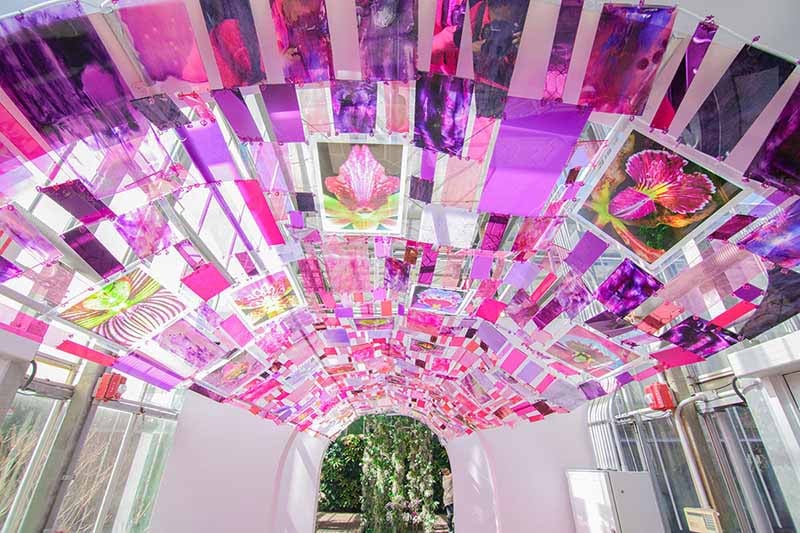When an exhibition whose dominant palette consists of transparent pinks, reds, roses and magentas opens in a garden on Valentine’s Day, one cannot help but think about the recent triumph of Barbie, the film about female self-discovery whose primary color palette is, of course, Barbie Pink.
Barbie Pink is an actual Pantone color: 219c. Atlanta artist Lillian Blades’ use of 219c and variations on the hues of orchids in her work currently on view at the Atlanta Botanical Garden partakes of the natural world but also shimmers with a layer of feminist engagement that reflects on Mother Nature and the intrinsic beauty of the natural world.

Through the Orchid Daze program, the Atlanta Botanical Garden has been working with artists and designers for more than two decades. Blades, this year’s participant, is known for her assemblage work comprised of found objects collaged on walls and, more recently, for free-floating hanging screens that flicker in the light. She has created four works under the subtitle Reflections in Bloom. They are being shown, through April 14, in the Fuqua Conservatory Lobby, Orchid Center Atrium and Orchid Display House surrounded by flowers and embedded in a lush and moist environment of verdant tropical plants.
The Atlanta Botanical Garden has the largest permanent collection of orchids in the United States. It was developed to give visitors to the garden a respite during the winter months inside the conservatories that are filled with color and tropical plants. There are more than 1,000 varieties of orchids in pots on display, as well as up to 200 species in flower that are paired with the artworks. The exhibition is a conversation between art and flora in the languages of color and light in a warm and sumptuous place.
Blades’ Untitled assemblage hangs on the wall in the lobby and is surrounded by Epidendrums, slipper orchids and dancing lady orchids. These plants are in bloom with intense and varied hues of reds, oranges, pinks and purples that augment the viewer’s perception of the palette of Blades’ artwork.

Untitled is large (8 x 12 feet) and layered with many found objects that include multiple ornately carved round or square picture frames. Some are empty, others enclose mirrors; one surrounds a clock with Roman numerals but no hands. The objects are placed on the surface like a garden plot seen in plan view. The geometry of circles and rectangles is visually arresting in its complication. The underpainted splattered surface’s palette ranges across a kind of garden spectrum from red to pink to fluorescent orange to golden yellow to lime green in a play on Jackson Pollock.
This work shimmers and pulses with energy and light. It is like a Mardi Gras parade or perhaps a Junkanoo, a costumed parade celebrated in the Bahamas where the artist was born. Since the work is adjacent to a large window, reflections on artwork and the mirrors play across its surface as the light changes during the day; the natural light and the grid of windows work with the artwork to its advantage.
The three other artworks in the exhibition are composed primarily of pieces of plexiglass spray-painted or painted with gels. These collages of color bridge the divide between art and craft in ways that recall the Pattern and Decoration Movement of the 1970s. Blades’ works hang like stained glass tapestries of transparent colored plexiglass panels joined with small fasteners, giving them the openness of screens.
Another Untitled work in the Orchid Display House is a quilt-like work that contains larger pieces of digital prints on plexiglass of the orchids’ anther and stigma, whose intensity of color connects them to the living plants. Even though these photographic images seem redundant alongside the orchids themselves, this work is the exhibition’s show-stopper.

Two works in the exhibition address the architecture and are suspended from the ceiling. As visitors walk down the corridor from the Fuqua Conservatory to the Orchid Center Atrium, they can look up at this work. This Untitled has a mosaic-like construction made with acrylic, plexiglass, stained glass, silver and aluminum wire, steel, acrylic paints/gels and spray paints. Walking through this work is charmingly interactive, like passing through a kaleidoscope.
After walking through the hallway, the visitor enters the Orchid Center Atrium and encounters a circular work, another Untitled, which is suspended from the ceiling and slightly domed (10 feet in diameter). This canopy is composed of circular plexiglass parts that are spray-painted with paints and gels in hues ranging from gold to orange and a varied array of pinks — much like the orchids in the collection. It is a delight to look up into this work overhead. There are circles within circles in Untitled whose form is both botanical and celestial.
Although nature has been a source of inspiration to artists for centuries, to collaborate with Mother Nature can be a daunting proposition. The success of Orchid Daze resides in the conversation between Blades’ color and light and the splendor of the orchids at the garden.
::
Deanna Sirlin is an artist and writer. She is known internationally for large-scale installations that have covered the sides of buildings from Atlanta to Venice, Italy. Her book, She’s Got What It Takes: American Women Artists in Dialogue (2013), is a critical yet intimate look at the lives and work of nine noted American women artists who have been personally important to Sirlin, based on conversations with each one.

